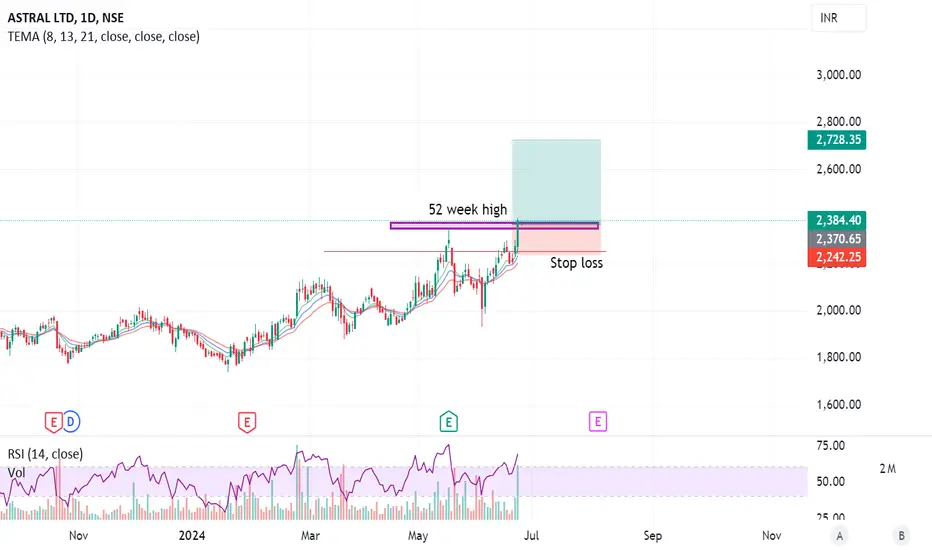Entry:
Look for stocks, including Astral Ltd. (NSE), that recently crossed their 52-week high. This suggests potential upward momentum.
Stop Loss:
Place a stop-loss order 8% below the entry price. This limits your potential downside if the price moves against you.
Target:
Aim for a profit target of more than 15% above the entry price. This offers a good reward-to-risk ratio (assuming an 8% stop loss).
Additional Considerations:
Confirmation: While the stock crossing its 52-week high is a good starting point, consider additional confirmation for the uptrend. This could include technical indicators like moving averages or relative strength index (RSI) showing upward movement.
Volatility: Be aware of the stock's typical price volatility. An 8% stop loss might be too tight for a highly volatile stock, potentially leading to unnecessary exits.
Risk Management: This strategy focuses on a single price target. You can consider a trailing stop-loss to lock in profits as the price moves up or take partial profits at specific intervals.
Backtesting: Before deploying this strategy with real capital, consider backtesting it on historical data to assess its effectiveness and tweak parameters like stop loss and target percentages.
Disclaimer: This is a basic strategy and should not be considered financial advice. Always do your own research before making any investment decisions.
Look for stocks, including Astral Ltd. (NSE), that recently crossed their 52-week high. This suggests potential upward momentum.
Stop Loss:
Place a stop-loss order 8% below the entry price. This limits your potential downside if the price moves against you.
Target:
Aim for a profit target of more than 15% above the entry price. This offers a good reward-to-risk ratio (assuming an 8% stop loss).
Additional Considerations:
Confirmation: While the stock crossing its 52-week high is a good starting point, consider additional confirmation for the uptrend. This could include technical indicators like moving averages or relative strength index (RSI) showing upward movement.
Volatility: Be aware of the stock's typical price volatility. An 8% stop loss might be too tight for a highly volatile stock, potentially leading to unnecessary exits.
Risk Management: This strategy focuses on a single price target. You can consider a trailing stop-loss to lock in profits as the price moves up or take partial profits at specific intervals.
Backtesting: Before deploying this strategy with real capital, consider backtesting it on historical data to assess its effectiveness and tweak parameters like stop loss and target percentages.
Disclaimer: This is a basic strategy and should not be considered financial advice. Always do your own research before making any investment decisions.
Disclaimer
The information and publications are not meant to be, and do not constitute, financial, investment, trading, or other types of advice or recommendations supplied or endorsed by TradingView. Read more in the Terms of Use.
Disclaimer
The information and publications are not meant to be, and do not constitute, financial, investment, trading, or other types of advice or recommendations supplied or endorsed by TradingView. Read more in the Terms of Use.
